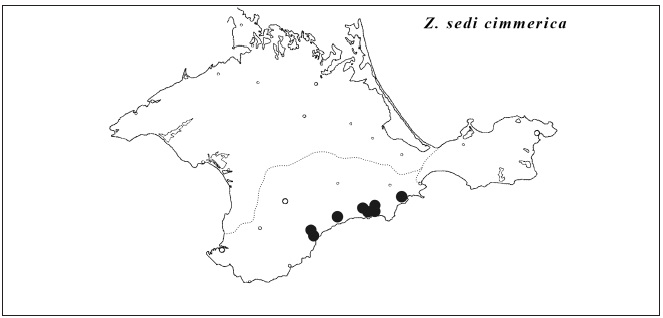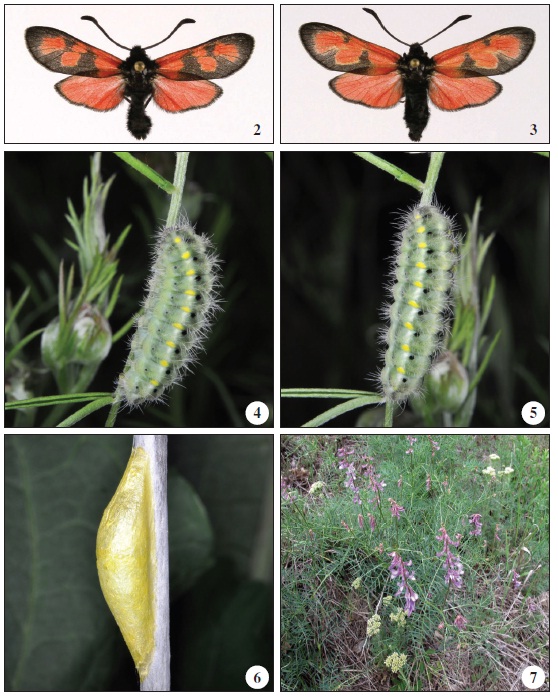

Artículos
Zygaena (Agrumenia) sedi cimmerica Efetov, a new subspecies from the Crimea (Lepidoptera: Zygaenidae, Zygaeninae)
Zygaena (Agrumenia) sedi cimmerica Efetov, una nueva subespecie de Crimea(Lepidoptera: Zygaenidae, Zygaeninae)
Zygaena (Agrumenia) sedi cimmerica Efetov, a new subspecies from the Crimea (Lepidoptera: Zygaenidae, Zygaeninae)
SHILAP Revista de Lepidopterología, vol. 46, no. 182, 2018
Sociedad Hispano-Luso-Americana de Lepidopterología
Received: 17 July 2017
Accepted: 15 January 2018
Published: 30 June 2018
Abstract: A new subspecies, Zygaena (Agrumenia) sedi cimmerica Efetov, subsp. n. is described from the Crimea.
Keywords: Lepidoptera, Zygaenidae, Zygaeninae, Zygaena, Z, sedi cimmerica, new subspecies, Crimea.
Resumen: Se describe una nueva subspecies de Crimea, Zygaena (Agrumenia) sedi cimmerica Efetov, subsp. n.
Palabras clave: Lepidoptera, Zygaenidae, Zygaeninae, Zygaena, Z, sedi cimmerica, nueva subespecie, Crimea.
Introduction
The family Zygaenidae is divided now into the five subfamilies: Inouelinae Efetov & Tarmann, 2017; Procridinae Boisduval, 1828; Chalcosiinae Hampson, 1893; Callizygaeninae Alberti, 1954; and Zygaeninae Latreille, 1809 (EFETOV & TARMANN, 2017; EFETOV, 2010; EFETOV et al., 2011, 2014). Zygaena (Agrumenia) sedi Fabricius, 1787, is a species of the tribe Zygaenini of the subfamily Zygaeninae (HOFMANN & TREMEWAN, 2017).
Z. sedi is distributed in the Crimea only in the eastern part of the Southern coast of the peninsula (EFETOV, 1989, 1996, 2004a, 2005; NAUMANN & NAUMANN, 1980). Hitherto this isolated population was attributed to the subspecies Zygaena (Agrumenia) sedi sedi Fabricius, 1787 (HOFMANN & TREMEWAN, 1996). However, Crimean specimens differ morphologically from those of nominotypical subspecies from Volga basin (type-locality ‘Russia meridionali’ [Saratov; Volgograd: Krasnoarmeysk (Sarepta)]. It was already noted by HOLIK & SHELJUZHKO (1956: 103): ‘Zeichnung stark reduziert, insbesondere fehlt die Fleckeneinfassung’. Thus, it is necessary to describe a new subspecies inhabiting eastern part of the Southern coast of the Crimea.
Abbreviations
CKAE - Collection of Konstantin A. Efetov, Crimean Federal University, Simferopol, Crimea.
TLMF - Collection of Tiroler Landesmuseen, Ferdinandeum, Hall, Austria.
Zygaena (Agrumenia) sedi cimmerica Efetov, subsp. n. (Figs 2, 3)
Material: Holotype ♂, length of the forewing 13.2 mm (Fig. 2), ‘CRIMEA, N of Sudak, Dachnoye, 100 m, 16-VI- 2008, leg. K. A. Efetov’ (CKAE).
Paratypes: 1 ♀, ‘CRIMEA, Alushta, 10 m, 5-VII-1987, leg. K. A. Efetov’ (CKAE); 6 ♂♂, ‘CRIMEA, vic. Alushta, Verkhnyaya Kutuzovka, 300 m, 8-VI-2003, leg. K. A. Efetov’ (CKAE); 1 ♂, ‘CRIMEA, vic. Alushta, Verkhnyaya Kutuzovka, 300 m, 16-VI-2003, leg. K. A. Efetov’ (CKAE); 1 ♂, 2 ♀♀, ‘CRIMEA, Karadag, 200 m, 21-VI-1987, leg. K. A. Efetov’ (CKAE); 1 ♂, ‘CRIMEA, NNW of Rybach’ye, 450 m, 21-VI-2003, leg. K. A. Efetov’ (CKAE); 25 ♂♂, 24 ♀♀, ‘CRIMEA, N of Sudak, Dachnoye, 100-160 m, leg. K. A. Efetov’: 1 ♀, 3-VII-1993 (CKAE); 4 ♂♂, ex larva, 7-V-1994, imagines emerged 26-V-1994, 27-V-1994, 29-V-1994, 30-V-1994 (CKAE); 1 ♀, ex larva, 7-V-1994, imago emerged 26-V-1994 (CKAE); 1 ♂, 1 ♀, 9-VI-1994 (CKAE); 2 ♂♂, 2 ♀♀, 12-VI-1996 (CKAE); 1 ♂, 1 ♀, 14-VI-1997 (CKAE); 3 ♂♂, ex larva, 10-V-1999, imagines emerged 8-VI-1999, 11-VI-1999, 15-VI-1999 (CKAE); 5 ♀♀, ex larva, 10-V-1999, imagines emerged 10-VI-1999 (2), 11-VI-1999, 13-VI-1999 (2) (CKAE); 1 ♀, ex larva, 18-V-2003, imago emerged 8VI-2003 (CKAE); 12 ♂♂, 10 ♀♀, (Fig. 3), 16-VI-2008 (CKAE); 2 ♂♂, 2 ♀♀, 16-VI-2008 (TLMF).
The holotype and paratypes have been supplied with printed pin-labels on red paper: ‘HOLOTYPUS [or PARATYPUS] ♂ [or ♀] Zygaena sedi cimmerica Efetov, 2018’.
Description: Length of forewing: males 11.1-14.0 mm; females: 13.4-15.5 mm. Head, antenna, thorax and abdomen black, hairy. Posterior parts of patagia mixed with white hair-like scales in some females. Black ground colour of forewings with weak bluish sheen. Forewing spots red, narrowly edged with yellowish white in females, edging of spots in males practically absent. Spots 1+2a+2b forming a large basal blotch (spot terminology follows the system of HOFMANN & TREMEWAN, 2017). Spots 3 and 4 confluent in females, but often separated in males. Spots 5 and 6 confluent and forming a reniform blotch. In males spots 1+2a+2b, 3+4 and 5+6 usually separated one from another, in females they are more or less connected. Hindwing red, with small hyaline area near base and with narrow black border (broader at apex). Abdominal cingulum absent.
Differential diagnosis: Z. sedi cimmerica Efetov, subsp. n. differs from the nominotypical subspecies by darker background of the forewings and reduced yellowish white edging of the forewing red spots, especially in males.
Ovum: Ovoid, pale yellow. Deposited on a leaf in a batch consisting of a single layer arranged in a row, the eggs slightly overlapping each other.
Larva (Figs 4, 5): Full-fed 14-16 mm long. Head and thoracic legs black; thorax and abdomen light green, with a narrow, whitish mediodorsal line; a small black dorsal spot in anterior part of each segment from second thoracic to eighth/ninth abdominal, a yellow spot beneath and in posterior part of each segment from second thoracic to seventh abdominal (on eighth abdominal segment this spot is white). Black anterior dorsal spots slightly stand out against the background of a dark grey dorso-lateral stripe. Spiracular stripe dark grey. Dorso-lateral and spiracular stripes represented by blackish suffusion below the cuticle. Peritreme of spiracles black. Setae white. Abdominal prolegs yellowish green. From middle of June to middle of May. After diapause the larvae can be found during sunny weather sitting on the young shoots at the top of the host-plant, feeding on the young leaves and flower buds.
Pupa and cocoon: Head, thorax, wings and appendages of pupa shining, black; abdomen emerald green with dark grey bands laterally, caudal region blackish, peritreme of spiracles black. Cocoon (Fig. 6) fusiform, yellow or light green, surface slightly wrinkled. Emergence of imago 11-14 days after the construction of the cocoon.
Biology: Host-plant (Fig. 7), in the Crimea the larvae are feeding on Vicia tenuifoloia Roth (= V. dalmatica A. Kerner; = V. elegans auct. non Guss.) (Fabaceae) (EFETOV, 1996; YENA, 2012). Univoltine subspecies. Moths on the wing from late May to early July. Inhabits relatively dry bushy slopes covered with Vicia where it flies actively in sunshine. Z. sedi has already been recorded by us as a pollinator of the orchid Anacamptis pyramidalis (L.) Rich. in the Crimea (NAZAROV & EFETOV, 2000). Pairs of hemipollinaria can be easily seen on the moth’s proboscis (EFETOV, 2005; NAZAROV & EFETOV, 1993).
Distribution: In the Crimea distributed only in the eastern part of the Southern coast of the peninsula (Fig. 1). This species has been found in the Crimea at Mt. Karadag (NAUMANN & NAUMANN, 1980), in surroundings of Sudak (EFETOV, 1996), Rybach’ye (EFETOV, 2005), Verkhnyaya Kutuzovka (EFETOV, 2005) and Alushta (EFETOV, 1989).

Etymology: Cimmeria is an ancient name of the Crimea, in a poetic tradition this name is attributed to south-eastern part of the peninsula.
Range of all subspecies of Zygaena sedi
Greece, Bulgaria, Turkey, Crimea, south of European part of Russia: area of lower Volga (ANIKIN et al., 2000; EFETOV, 1989, 1996, 1998a,1998b, 2004b, 2005; HOFMAN & TREMEWAN, 1996; NAUMANN et al., 1984, 1999).
Z. sedi sedi Fabricius, 1787. Area of lower Volga (Saratov Region, Volgograd Region, Astrakhan’ Region).
Z. sedi cimmerica Efetov, subsp. n. Eastern part of Southern cost of the Crimea.
Z. sedi sliwenensis Reiss, 1933. Bulgaria. Whitish edging of forewing spots pronounced, though usually somewhat suffused (NAUMANN et al., 1999).
Z. sedi dellabrunai Dujardin, 1981. North-western Greece. Forewing spots lacking suffused confluence, with 1+2+2a separate from 3+4+5+6, the latter only weakly connected, patagia and tegulae variably intermixed with red (NAUMANN et al., 1999).
Z. sedi roxana Naumann & Naumann, 1980. Turkey. Similar to subspecies Z. sedi sedi, but confluence of forewing spots much more pronounced (NAUMANN et al., 1999).
Acknowledgement
I am indebted to Mr Axel Hofmann (Linkenheim-Hochstetten, Germany) for fruitful discussions and important information.
BIBLIOGRAPHY
ANIKIN, V. V., SACHKOV, S. A. & ZOLOTUHIN V. V., 2000.– “Fauna lepidopterologica Volgo-Uralensis” 150 years later: changes and additions. Part 2. Bombyces and Sphinges (Insecta, Lepidoptera).– Atalanta, 31(1/2): 265-292.
EFETOV, K. A., 1989.– New findings of the Zygaenidae (Lepidoptera) in the Crimea.– Vestnik Zoologii, 23(1): 87.
EFETOV, K. A., 1996.– The early stages of Zygaena (Agrumenia) sedi Fabricius, 1787 (Lepidoptera: Zygaenidae).– Entomologist’s Gazette, 47(1): 27-29.
EFETOV, K. A., 1998a.– A review of the fauna of the Zygaenidae (Lepidoptera) of the Volga region: II. Subfamily Zygaeninae, p. 150.– In Problems of Entomology in Russia, 1: 244 pp. Zoologicheskiy Institut RAN, St. Petersburg.
EFETOV, K. A., 1998b.– The fauna of the Zygaenidae (Lepidoptera) of the Volga region, pp. 58-60.– In Problems of Entomology of European Part of Russia and Adjacent Territories: 160 pp. Samarskiy Universitet, Samara.
EFETOV, K. A., 2004a.– Propositions on the inclusion of Zygaenidae species in the Red Data Book of Ukraine, pp. 4-5.– In Conference of Ukrainian Entomological Society ‘Ridkisni ta znykayuchi vydy komakh ta kontseptsii Chervonoi knygy Ukrainy’: 12 pp. Kiev.
EFETOV, K. A., 2004b.– Forester and Burnet Moths (Lepidoptera: Zygaenidae). The genera Theresimima Strand, 1917, Rhagades Wallengren, 1863, Zygaenoprocris Hampson, 1900, Adscita Retzius, 1783, Jordanita Verity, 1946 (Procridinae), and Zygaena Fabricius, 1775 (Zygaeninae): 272 pp. CSMU Press, Simferopol.
EFETOV, K. A., 2005.– The Zygaenidae (Lepidoptera) of the Crimea and other regions of Eurasia: 420 pp. CSMU Press, Simferopol.
EFETOV, K. A. 2010.– Illiberis (Hedina) louisi sp. nov. (Lepidoptera: Zygaenidae, Procridinae) from China.– Entomologist’s Gazette, 61(4): 235-241.
EFETOV, K. A., HOFMANN, A., TARMANN, G. M. & TREMEWAN, W. G., 2014.– Taxonomic comments on the treatment of the Zygaenidae (Lepidoptera) in volume 3 of Moths of Europe, Zygaenids, Pyralids 1 and Brachodids (2012).– Nota lepidopterologica, 37(2): 123-133.
EFETOV, K. A., SUBCHEV, M. A., TOSHOVA, T. B. & KISELEV, V. M. 2011.– Attraction of Zygaenoprocris taftana (Alberti, 1939) and Jordanita horni (Alberti, 1937) (Lepidoptera: Zygaenidae, Procridinae) by synthetic sex pheromones in Armenia.– Entomologist’s Gazette. 62(2): 113- 121.
EFETOV, K. A. & TARMANN, G. M., 2017.– The hypothetical ground plan of the Zygaenidae, with a review of the possible autapomorphies of the Procridinae and the description of the Inouelinae subfam. nov..– Journal of the Lepidopterists’ Society, 71(1): 20-49.
HOFMANN, A. & TREMEWAN, W. G., 1996.– A Systematic Catalogue of the Zygaeninae (Lepidoptera: Zygaenidae): 251 pp. Harley Books, Colchester.
HOFMANN, A. F. & TREMEWAN, W. G., 2017.– The Natural History of Burnet Moths (Zygaena Fabricius, 1775) (Lepidoptera: Zygaenidae). Part 1: 631 pp. Museum Witt, Munich.
HOLIK, O. & SHELJUZHKO, L., 1956.– Über die Zygaenen-Fauna Osteuropas, Kleinasiens, Irans, Zentralasiens und Sibiriens. 2 Fortsetzung.– Mitteilungen der Münchner Entomologischen Gesellschaft, 56: 93-239.
NAUMANN, C. M., FEIST, R., RICHTER, G. & WEBER, U., 1984.– Verbreitungsatlas der Gattung Zygaena Fabricius, 1775 (Lepidoptera, Zygaenidae): 45 pp., 97 maps. Verlag von J. Cramer, Braunschweig.
NAUMANN, S. & NAUMANN, C. M., 1980.– Ein Beitrag zur Kenntnis der Zygaenen-Fauna Nord- und Ost-Anatoliens (Lep., Zygaenidae).– Entomofauna, 1: 302-353.
NAUMANN, C. M., TARMANN, G. M. & TREMEWAN, W. G., 1999.– The Western Palaearctic Zygaenidae (Lepidoptera): 304 pp. Apollo Books, Stenstrup.
NAZAROV, V. V. & EFETOV, K. A., 1993.– On the role of Zygaenidae (Lepidoptera) in pollination of Anacamptis pyramidalis (Orchidaceae).– Zoologichesky Zhurnal, 72(10): 54-67.
NAZAROV, V. V. & EFETOV, K. A., 2000.– Preliminary results of searching in collections for zygaenid moths that have pollinated the orchid Anacamptis pyramidalis (L.) Rich. (Lepidoptera: Zygaenidae, Zygaeninae).– In G. M. TARMANN & W. G. TREMEWAN (Eds). VII International Symposium on Zygaenidae (Innsbruck, 4-8 September 2000): 22. Innsbruck.
YENA, A. V., 2012.– Spontaneous Flora of the Crimean Peninsula: 232 pp. N. Orianda, Simferopol.
Figures

Notes